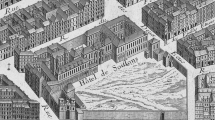Abstract
Scarpa's architecture in Palermo has undergone several maintenance or restoration interventions over time. Scarpa works with great attention to the existing structures and the museum installations are real stage machines, complex gears to be deciphered in order to be adequately preserved. In Vladimir Zoric's interventions there is this great attention to the study of the complexity of the materials used, in relation to the local components but also to what we now recognize as a clear and unmistakable formal language. The paper studies the works of Carlo Scarpa in Palermo in two important sites: the museum organization of Palazzo Abatellis and the collaboration in the adaptation to the seat of the Rectorate of Palazzo Steri. The restoration work on these buildings became necessary just thirty years after their construction. This is due to the materials used and the unscrupulous construction techniques often pushed to the extreme limits of strength and durability. The intervention required for the adaptation of the systems and safety equipment was different. Both at Palazzo Abatellis and at the Steri there has been a change in the intended use of some rooms which entailed adaptations and modifications that are not always in line with the aims of the project, generating a real anthropic degradation. Zoric's program for Palazzo Abatelis starts from Scarpa's techniques. In fact, he knew Scarpa's language well, having often collaborated with the master and having designed together with him some permanent installations of the museum. In the paper I wanted to remember how Vladimir Zoric, with extreme sensitivity, solves the problem of lighting adaptation by opting for light sources hidden from view. He wisely uses inexpensive elements, such as fluorescent neon tubes, which are placed on the roof, in positions hidden from the view of museum users and able to give diffused and non-punctual lighting, as in the frames of the dome-skylight of the ancient Chapel of the Palace. The comparison with the latest extension works of the National Gallery is an opportunity to reflect on the methods of intervention in historic buildings. Scarpa's lesson at the Steri is declined between agreements and contrasts, modern materials used in an ancient way and ancient techniques that give a new shape to iron and concrete. The analysis of the cases addressed in the paper shows many ideas to reflect on. There is a close relationship between conservation, restoration and maintenance. Years later we are witnessing the need for “restoration of the restoration” but it can be said that both at Steri and Abatellis it is the so-called anthropic degradation that causes the greatest damage and causes heavy transformations in the work of Carlo Scarpa.
Access this chapter
Tax calculation will be finalised at checkout
Purchases are for personal use only
Similar content being viewed by others
Notes
- 1.
On 29 March 1963 the superintendent Giuseppe Giaccone wrote to Comm. Girolamo Ardizzone, director of the Giornale di Sicilia: “I would be grateful if you would like to inform the readers of your newspaper that the Prize for the restoration of Palazzo Abatellis in Palermo awarded to Prof. Scarpa will concern other merits but not that of “restoration”», Historical Archive of the Superintendence of Cultural and Environmental Heritage of Palermo, fasc. Mon. 297.
- 2.
Vladimir Zoric was born in Sibenik (Croatia) on August 13, 1934. From 1962 to 1970 he attended the Faculty of Architecture of the University of Palermo. Since 1970 he has collaborated assiduously with figures of the stature of Vittorio Gregotti, Roberto Calandra and Leonardo Benevolo. From 1985 to 1988 he was an adjunct professor at the Faculty of Architecture of Palermo, where he taught History of Technologies, Techniques and Building Systems in Architecture for Restoration. He worked diligently until 2005.
References
Campo, G. (2006). Roberto Calandra architetto e maestro. Per Salvare Palermo, 14, 8–10.
Iannello M. Scolaro G. (2009). Palermo. Guida all'architettura del '900, pp. 202–205, Fondazione Salvare Palermo
Lima A. I. (2006). Lo Steri di Palermo nel secondo Novecento, Dario Flaccovio Editore
Manzelle M. (2002). Carlo Scarpa. L’opera e la sua conservazione (1998–2000). Giornate di studio alla Fondazione Querini Stampalia, Skira
Marcianò A.F. (1984). Carlo Scarpa, Zanichelli
Miotto L. (2004). Carlo Scarpa. I musei, Testo & Immagine, pp.77–81
Morello P. (2018). Carlo Scarpa. L’allestimento della Galleria di Palazzo Abatellis a Palermo, 1953–54. https://www.domusweb.it/it/speciali/manifesta/2018/carlo-scarpa-lallestimento-della-galleria-di-palazzo-abatellis-a-palermo-1953-54.html
Polano S. (1996). Carlo Scarpa: Palazzo Abatellis, Electa
Vicari, N. (1988). Il palazzo Chiaramonte detto Steri. Il Suo Recupero a La Sua Destinazione a Rettorato Dell’università Di Palermo, Recuperare, n, 37, 560–571.
Zoric V. (1985). Per la Galleria Regionale di Palazzo Abatellis e l’illuminazione artificiale della stessa, Monumenti del Cinquecento meridionale. Restauri e recuperi, Attività divulgativa e didattica della Galleria Regionale di Palermo
Zoric V. (1985). Il restauro museografico all'opera di Carlo Scarpa. Monumenti del Cinquecento meridionale. Restauri e recuperi, Attività divulgativa e didattica della Galleria Regionale di Palermo
Author information
Authors and Affiliations
Corresponding author
Editor information
Editors and Affiliations
Rights and permissions
Copyright information
© 2024 The Author(s), under exclusive license to Springer Nature Switzerland AG
About this paper
Cite this paper
Accetta, C. (2024). Carlo Scarpa in Palermo: Vladimir Zoric and the Restoration Experiences at Palazzo Abatellis and the Transformations of the Steri. In: Germanà, M.L., Akagawa, N., Versaci, A., Cavalagli, N. (eds) Conservation of Architectural Heritage (CAH). CAH 2022. Advances in Science, Technology & Innovation. Springer, Cham. https://doi.org/10.1007/978-3-031-33222-7_18
Download citation
DOI: https://doi.org/10.1007/978-3-031-33222-7_18
Published:
Publisher Name: Springer, Cham
Print ISBN: 978-3-031-33221-0
Online ISBN: 978-3-031-33222-7
eBook Packages: Earth and Environmental ScienceEarth and Environmental Science (R0)




